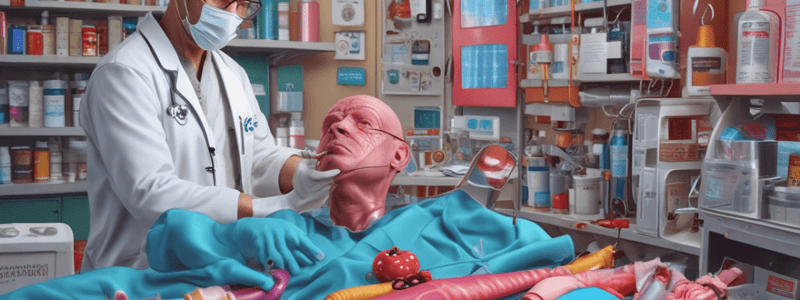Podcast
Questions and Answers
Which of the following is NOT a presenting symptom highlighted in the 'bones, stones, moans, and groans' mnemonic?
Which of the following is NOT a presenting symptom highlighted in the 'bones, stones, moans, and groans' mnemonic?
- Skeletal pain
- Abdominal discomfort
- Fever (correct)
- Nephrolithiasis
What is the most reliable laboratory test to detect hypercalcemia?
What is the most reliable laboratory test to detect hypercalcemia?
- Measuring albumin levels
- Measuring total calcium
- Measuring ionized calcium (correct)
- Measuring parathyroid hormone levels
When measuring total calcium, which of the following is important to consider?
When measuring total calcium, which of the following is important to consider?
- Correcting for renal function
- Correcting for parathyroid hormone levels
- Correcting for hypoalbuminemia (correct)
- Correcting for hyperalbuminemia
What is the likely more significant factor in determining whether a patient becomes symptomatic from hypercalcemia?
What is the likely more significant factor in determining whether a patient becomes symptomatic from hypercalcemia?
Which of the following is NOT a potential sign or symptom of hypercalcemia?
Which of the following is NOT a potential sign or symptom of hypercalcemia?
What is the effect of hypercalcemia on the QT interval?
What is the effect of hypercalcemia on the QT interval?
Which of the following can cause abdominal pain in the setting of hypercalcemia?
Which of the following can cause abdominal pain in the setting of hypercalcemia?
What is the relationship between hypercalcemia and kidney stone formation?
What is the relationship between hypercalcemia and kidney stone formation?
Which of the following cancers is least likely to cause hypercalcemia despite frequently metastasizing to bone?
Which of the following cancers is least likely to cause hypercalcemia despite frequently metastasizing to bone?
Which range is considered normal for serum calcium levels?
Which range is considered normal for serum calcium levels?
Which of the following is the most common cause of hypercalcemia among hospitalized patients?
Which of the following is the most common cause of hypercalcemia among hospitalized patients?
Which of the following mechanisms can lead to hypercalcemia in cancer patients?
Which of the following mechanisms can lead to hypercalcemia in cancer patients?
Which of the following statements is true regarding the symptoms of hypercalcemia?
Which of the following statements is true regarding the symptoms of hypercalcemia?
Which of the following cancers is most likely to cause hypercalcemia through bone metastases?
Which of the following cancers is most likely to cause hypercalcemia through bone metastases?
Which of the following body systems can be affected by oncological emergencies?
Which of the following body systems can be affected by oncological emergencies?
Which of the following conditions is classified as a metabolic oncological emergency?
Which of the following conditions is classified as a metabolic oncological emergency?
What is the role of measuring parathyroid hormone-related peptide (PTHrP) in initial management of hypercalcemia?
What is the role of measuring parathyroid hormone-related peptide (PTHrP) in initial management of hypercalcemia?
Which test is considered more readily available to support a diagnosis of humoral hypercalcemia?
Which test is considered more readily available to support a diagnosis of humoral hypercalcemia?
What effect can PTHrP have on endogenous parathyroid hormone (PTH) levels in patients with humoral hypercalcemia?
What effect can PTHrP have on endogenous parathyroid hormone (PTH) levels in patients with humoral hypercalcemia?
What is the cornerstone of initial management for hypercalcemia?
What is the cornerstone of initial management for hypercalcemia?
At what rate can normal saline be safely infused in a patient with hypercalcemia if they have intact left ventricular systolic function?
At what rate can normal saline be safely infused in a patient with hypercalcemia if they have intact left ventricular systolic function?
Which medication can be initiated to promote calciuresis after volume depletion has been corrected in a patient with hypercalcemia?
Which medication can be initiated to promote calciuresis after volume depletion has been corrected in a patient with hypercalcemia?
What is the suggested interval for administering furosemide intravenously in a patient with hypercalcemia for promoting calciuresis?
What is the suggested interval for administering furosemide intravenously in a patient with hypercalcemia for promoting calciuresis?
When should urgent intervention be considered in a patient with hypercalcemia?
When should urgent intervention be considered in a patient with hypercalcemia?
What is the mechanism by which antidiuretic hormone promotes free water uptake in the distal tubules?
What is the mechanism by which antidiuretic hormone promotes free water uptake in the distal tubules?
What can contribute to continued free water intake in euvolemic hyponatremic patients with cancer?
What can contribute to continued free water intake in euvolemic hyponatremic patients with cancer?
Where is SIADH more commonly encountered based on the location of primary and metastatic tumors?
Where is SIADH more commonly encountered based on the location of primary and metastatic tumors?
Which of the following cancers has a significant percentage of patients showing evidence of SIADH?
Which of the following cancers has a significant percentage of patients showing evidence of SIADH?
Which of the following drugs can cause SIADH as an iatrogenic cause of hyponatremia?
Which of the following drugs can cause SIADH as an iatrogenic cause of hyponatremia?
How does SIADH primarily affect the extracellular fluid volume in euvolemic hyponatremic patients with cancer?
How does SIADH primarily affect the extracellular fluid volume in euvolemic hyponatremic patients with cancer?
What is the primary issue with the thirst mechanism in euvolemic hyponatremic patients with cancer?
What is the primary issue with the thirst mechanism in euvolemic hyponatremic patients with cancer?
What is the etiology of hyponatremia in patients receiving potentially causative medications such as cisplatin?
What is the etiology of hyponatremia in patients receiving potentially causative medications such as cisplatin?
Which statement is true regarding the use of thiazide diuretics in managing hypercalcemia?
Which statement is true regarding the use of thiazide diuretics in managing hypercalcemia?
Which of the following statements about hemodialysis is true, according to the text?
Which of the following statements about hemodialysis is true, according to the text?
Which of the following statements is true regarding the use of glucocorticoids in managing hypercalcemia?
Which of the following statements is true regarding the use of glucocorticoids in managing hypercalcemia?
Which of the following nursing assessments is NOT mentioned in the text for managing hypercalcemia?
Which of the following nursing assessments is NOT mentioned in the text for managing hypercalcemia?
Which of the following statements is true regarding fluid management in hypercalcemia?
Which of the following statements is true regarding fluid management in hypercalcemia?
Which of the following nursing interventions is NOT mentioned in the text for managing hypercalcemia?
Which of the following nursing interventions is NOT mentioned in the text for managing hypercalcemia?
Which of the following statements is true regarding the assessment of hyponatremia in cancer patients?
Which of the following statements is true regarding the assessment of hyponatremia in cancer patients?
Which of the following statements is NOT true based on the information provided in the text?
Which of the following statements is NOT true based on the information provided in the text?
Study Notes
Hypercalcemia
- Presents with skeletal pain, nephrolithiasis, abdominal discomfort, and altered mentation
- Mnemonic: "bones, stones, moans, and groans"
- Bone pain usually due to discrete metastasis rather than diffuse calcium liberation
- Abdominal pain can arise from dysregulated intestinal motility, pancreatitis, or severe constipation
- Changes in sensorium can occur along a spectrum from lethargy to coma
- Hypercalcemia shortens QT interval and can produce cardiac arrhythmias
- Other signs and symptoms include fatigue, lethargy, constipation, stupor, and coma
Diagnosis
- Ionized calcium is the most reliable laboratory test to detect hypercalcemia (>1.29 mmol/L)
- Total calcium levels should be corrected for hypoalbuminemia
- No absolute level of calcium at which patients become symptomatic; rate of increase likely more significant than magnitude of elevation
Pathophysiology
- Hypercalcemia affects up to one-third of cancer patients
- Most common causes: breast, lung, and renal cell carcinomas; multiple myeloma; and adult T-cell leukemia/lymphoma
- Bone metastases can cause local paracrine effect, leading to bone resorption and hypercalcemia
- Prostate cancer rarely causes hypercalcemia
Management
- Hydration is the cornerstone of initial management
- Correction of volume depletion helps restore urine output
- Loop diuretics can be initiated to promote calciuresis
- Glucocorticoids can help mediate the release of cytokines and prostaglandins that stimulate osteoclasts
- Hemodialysis may be a faster and less hazardous method of correcting hypercalcemia in patients with diminished kidney function
Nursing Management
- Assess level of consciousness and neuromuscular status
- Monitor cardiac rate and rhythm, and be aware of cardiac arrest risk
- Monitor intake and output, and calculate fluid balance
- Encourage fluid intake of 3-4 liters per day, including sodium-containing fluids
- Promote frequent repositioning and range-of-motion exercises with caution
Hyponatremia
- Assessment requires critical determination of volume status
- Euvolemic hyponatremic patients have normal extracellular fluid volume but excessive water in the intravascular space
- SIADH is suspected in patients with lung, pleura, thymus, or brain tumors
- Iatrogenic causes of hyponatremia include cisplatin, cyclophosphamide, ifosfamide, vinca alkaloids, and imatinib
Studying That Suits You
Use AI to generate personalized quizzes and flashcards to suit your learning preferences.
Related Documents
Description
Test your knowledge on hypercalcemia, a high calcium level in the blood serum, as part of metabolic oncological emergencies. Learn about the normal range of calcium levels and the implications of hypercalcemia on the body systems.




